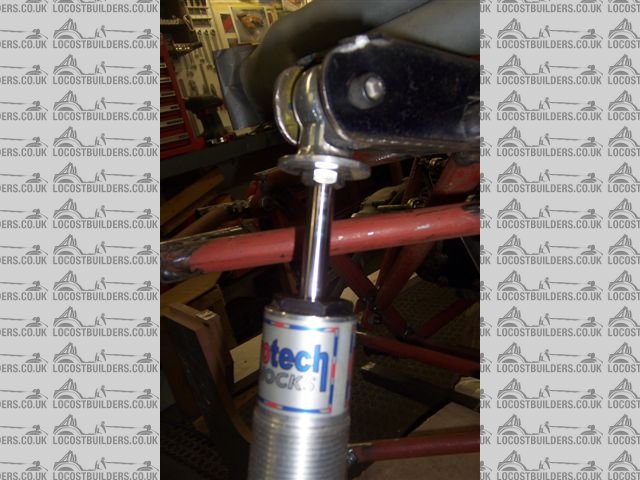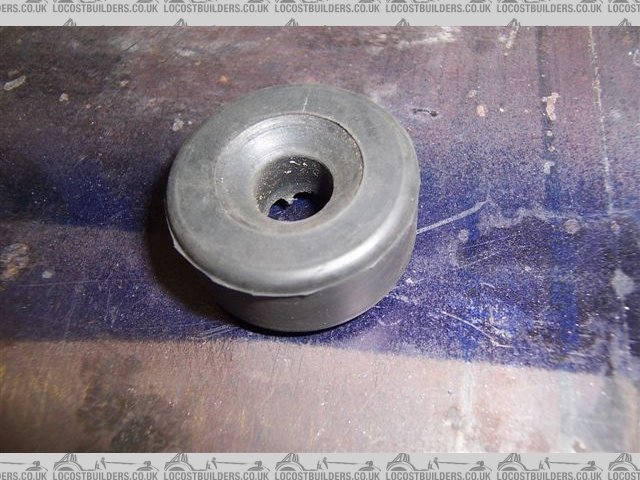Fred W B
|
| posted on 17/11/14 at 06:45 PM |

|
|
Bump stop rubber reducing the travel of the coil over?
Evening All
I'm pretty close to finally defining all the hard points in my rear suspension geometry while trying to get over a bought of analysis
paralysis.
I've got Protech coilovers, my question is when designing the mounting point positions do you take any account of the bump stop rubber reducing
the travel of the coil over? The bump stop is an 18 mm thick rubber doughnut with big chamfers cast into it on both sides, such that the height of the
full thickness is about 10 mm. I've tried to show it in the attached pictures, I've removed it from the coil over in the picture. I guess
the nut on the bumper rod will seat into it on full compression.
So when designing the travel do I:
1. Assume it will reduce the travel by about 10 mm at full bump?
2. Assume it will compress to about 5 mm at full bump?
3. Ignore it completely ?
I know the question is academic but its nice to get theory and practice to match where possible
Cheers
Fred W B


[Edited on 17/11/14 by Fred W B]
You can do it quickly. You can do it cheap. You can do it right. Pick any two.
|
|
|
|
|
mark chandler
|
| posted on 17/11/14 at 06:56 PM |

|
|
I would design so that the shock cannot bottom out and treat the bump stop is just a bonus.
|
|
|
Slimy38
|
| posted on 17/11/14 at 07:08 PM |

|
|
quote:
Originally posted by mark chandler
I would design so that the shock cannot bottom out and treat the bump stop is just a bonus.
I'd agree, I know there are some suspension systems that use the bump stop as a key part of the design, but on mine I'm aiming for it to
be a safety net in case of potholes.
|
|
|
Fred W B
|
| posted on 17/11/14 at 07:13 PM |

|
|
quote:
I would design so that the shock cannot bottom out
How do you do that then? I'm working it out without any spring fitted, only once the car is complete and the weights confirmed will the first
try spring rate be established.
[Edited on 17/11/14 by Fred W B]
You can do it quickly. You can do it cheap. You can do it right. Pick any two.
|
|
|
CNHSS1
|
| posted on 17/11/14 at 07:21 PM |

|
|
The likes of Koni and Eibach have data sheets for their motorsport bump rubbers. These show a rising rate graph of the effect of the bump rubber on
the spring rate, whereas a lot of shock bump rubbers are damage avoidance devices. The issue on a light car is that generally the spring rates are
relatively low and when the std bump rubbers come into play, the spring rate is effectively quadrupled or more in a few mm of travel.
Most clubman single seaters would use the proper bump rubbers to add some progression to the handling and spring rate. If you are using 250lb springs
and the std bump rubbers effectively make the spring rate 1000lb when in contact, whilst that chassis was saved in theory, that fact that you went off
the road the instant the spring rate went skywards is somewhT pointless!! Ideally a progresive rate bump rubber that started at an additional 50lb or
100lb would be more suitable, progressing stiffer to avoid chassis/suspension damage as per the std rubbers.
a bump rubber can be a great tuning aid to the handlingwith only a little thought and not much cost.
Find your local Koni, Ohlins or eibach motorsport dealer or any local single seater prep firm with a clue and hopefully a shock dyno,and they will
assist :-)
"Racing is life, everything else, before or after, is just waiting"---Steve McQueen
|
|
|
mark chandler
|
| posted on 17/11/14 at 07:40 PM |

|
|
quote:
Originally posted by Fred W B
quote:
I would design so that the shock cannot bottom out
How do you do that then? I'm working it out without any spring fitted, only once the car is complete and the weights confirmed will the first
try spring rate be established.
[Edited on 17/11/14 by Fred W B]
Sorry, I cannot help you with that, it's just whatever you design for hit a curb and the force will be far above what you expect.
I have got some progressive rate springs to try next year, 450lb moving to 850lb under heavy load for my DB7, standard is 470lb linear so I,m hoping
for softer ride on the flat with the car running flatter on the twisty bits.
In some race classes you have to use OEM springs, then bump stops are used as extra springs, effectively what my dual rate ones will do just in a
single package.
The bump stop in your picture is really a curb basher, not a long progressive bump stop.
Regards Mark
[Edited on 17/11/14 by mark chandler]
|
|
|
Fred W B
|
| posted on 17/11/14 at 08:01 PM |

|
|
quote:
The bump stop in your picture is really a curb basher, not a long progressive bump stop.
I do understand that
You can do it quickly. You can do it cheap. You can do it right. Pick any two.
|
|
|
40inches
|
| posted on 17/11/14 at 08:41 PM |

|
|
Interesting web site on the subject Eibach
|
|
|
DIY Si
|
| posted on 18/11/14 at 06:25 PM |

|
|
I'm designing my suspension as though the bump stops reduce total travel, ie they are there for when things go beyond what I expect and should
have no direct effect on the suspension ordinarily. I don't like the idea of using them as a springing method on mainly road use cars. Track or
race cars, then fair enough to use them. But for road use you shouldn't be curb bashing or having to handle very high speed bumps, in an ideal
world of course.
This did mean I had to get creative with a few clearance methods, but I want my bump stops to be there to save the chassis from damage only.
Let your plans be dark and as impenetratable as night, and when you move, fall like a thunderbolt.
Sun Tzu, The Art of War
My new blog: http://spritecave.blogspot.co.uk/
|
|
|
CNHSS1
|
| posted on 18/11/14 at 07:21 PM |

|
|
Almost every road car made today will have its bumstops designed as part of the springing regime rather than just to save the chassis/wishbones over a
huge pothole at speed
"Racing is life, everything else, before or after, is just waiting"---Steve McQueen
|
|
|
Slimy38
|
| posted on 18/11/14 at 08:41 PM |

|
|
quote:
Originally posted by DIY Si
But for road use you shouldn't be curb bashing or having to handle very high speed bumps, in an ideal world of course.
I take it your council is quite extravagant with their 'pothole fixing fund'?  Our council just seems more willing to pay for car damage
than actually fix the source, and I've had more than my fair share of suspension thumps as I bounce down (and then out of) what can only be
described as canyons in the road! Our council just seems more willing to pay for car damage
than actually fix the source, and I've had more than my fair share of suspension thumps as I bounce down (and then out of) what can only be
described as canyons in the road!
Is there any need to consider getting coil bound? I can't remember what gaps are in my springs, I'm 80% sure it will hit the bump stops
before the springs fully compresses, is that always the case?
[Edited on 18/11/14 by Slimy38]
|
|
|
CNHSS1
|
| posted on 18/11/14 at 08:51 PM |

|
|
Bump rubbers should be in play before coil bound. If it becomes coil bound in a big pot hole it could shear the mounts of the chassis relatively
easily
"Racing is life, everything else, before or after, is just waiting"---Steve McQueen
|
|
|
DIY Si
|
| posted on 19/11/14 at 12:10 PM |

|
|
My local roads aren't too bad as it goes. But then I live in a rural area, so whilst I expect some, there aren't enough to be a worry in
any way. Horses are far more of a risk!
I'm imagine just about every car designed will use the bump stops some how, but that's for big manufacturers I suspect. As a man in a
shed, I'd prefer to make things simple for myself where I can and I'm aiming for my bump stops to come into play only when needed, ie big
holes etc. I have what I think is at least enough travel for my set up.
As said, going coil bound is a really bad idea! It puts all the forces directly onto the mounts and is quite likely to damage something.
Let your plans be dark and as impenetratable as night, and when you move, fall like a thunderbolt.
Sun Tzu, The Art of War
My new blog: http://spritecave.blogspot.co.uk/
|
|
|













